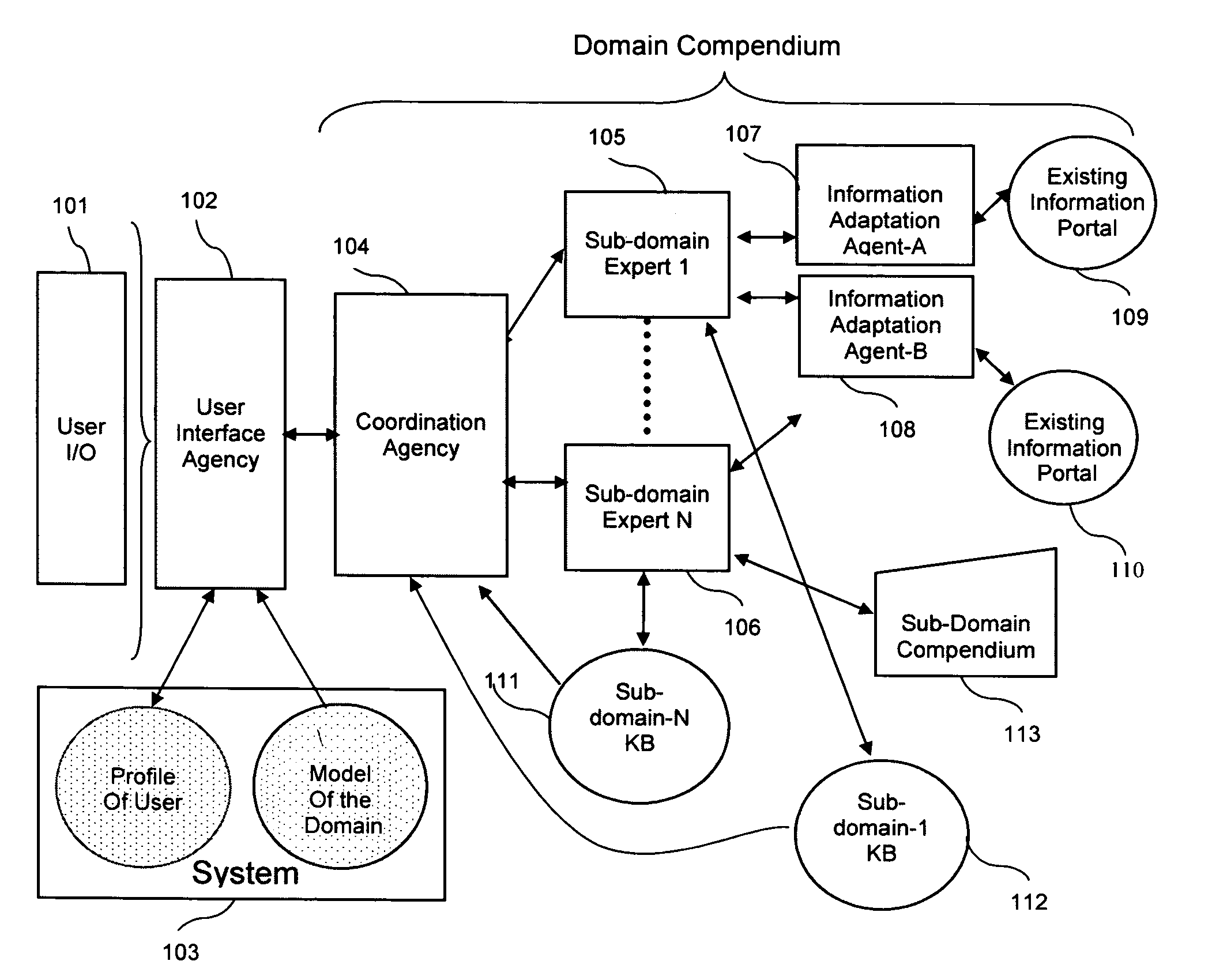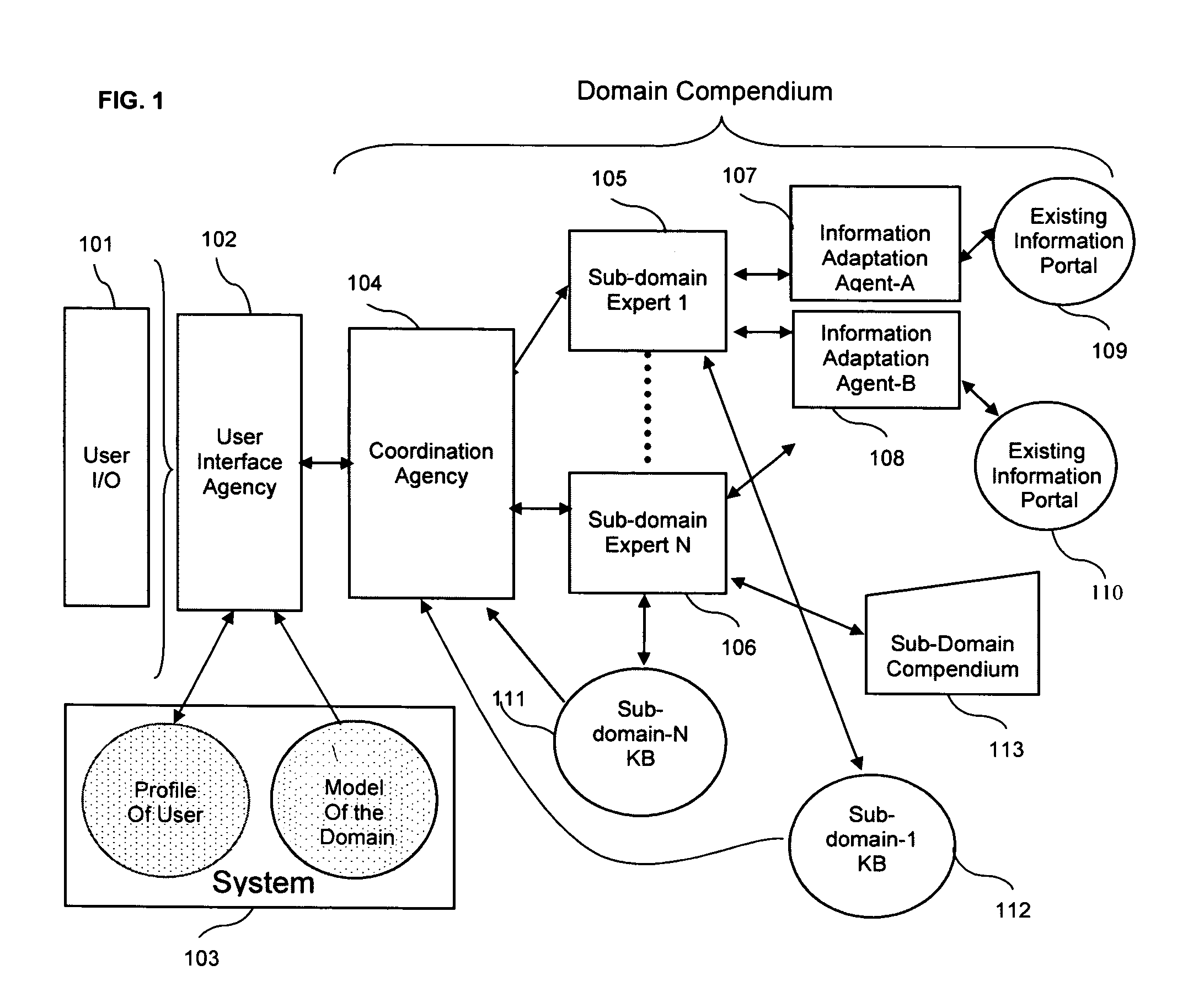Unfortunately, there is no monolithic, domain-independent body of knowledge that can accurately supply enough information concerning likely user mental states, to make a universal interface practical.
Consequently, a static set of models can never be satisfactory for long.
Few previous computer interface systems have attempted to deduce user goals and intent, as this is a very difficult task requiring a sophisticated representation of the domain of discourse, of the user, and of the way that language is used for the given domain.
Additionally, most systems are forced to ignore the context of interactions, as they do not provide a full representation of the user's previous communications, and of the information that resulted from prior interaction.
U.S. Pat. No. 5,255,386 omits a facility for domain modeling, discloses no way for composing domain knowledge, and provides no means capturing and generalizing previous or expert interactions.
However, the specification discloses no mechanism to represent the potential goals and intentions of a user, and describes only a surface-level syntactic analysis of the user's text, rendering the system incapable of exhibiting intelligent behavior.
Also, no attempt is made to understand the unique context of the user, beyond knowing which language (e.g. English v. French) he or she is using.
The system fails to achieve the requisite robustness because it is attempting to match the surface aspects of input language to output language, with no attempt to represent the meaning of the communication or the intentions of the user.
The system provides no mechanism for modeling the user or the domain (beyond that of the particular application) so it cannot be used for the broad range of tasks that users wish to accomplish.
However, Wachtel only describes the facility to represent the surface parse of natural language input; it does not represent or consider the meaning or intention of the user who communicated that input.
However, the Della Pietra system has no way of relating those mappings to a model of the user, his thoughts and intentions, and to the communications peculiar to a given domain, or to the recent history of discourse.
However, it includes no mechanism for representing domain knowledge, discourse plans and goals, or (conversational) problem-solving approaches, nor any way to compose multiple domain knowledge sources into a single repository.
Thus, it does not enable or use prerequisite information to accurately assess the goals, intentions and meanings of users.
Without such representation, and the capability of drawing inferences about user intentions, the system will never be capable of behaving as if it understands natural language queries and statements
This system supports some distribution of the knowledge used in interpreting the user's requests, but lacks a model of the user, his goals, or intentions.
The system also lacks a model of the domain which is independent of the particular web servers with which it communicates.
Because of this deficiency, the system is unable to understand requests that span multiple web servers, or to accomplish the tasks that will satisfy such requests.
The system uses some historical model of the user and accepts a limited subset of natural language input, but lacks a model of the goals that a user might possess, the mapping of those goals to language, or to the concepts that can be referred to in a domain, beyond the strict limits of a single software application.
Nakajima does not, however, include any method for understanding the meaning and intentions of the user.
However, this reference focuses primarily on spoken, typed or handwritten communications from users, and lacks any deep model of discourse and similarly lacks a domain model beyond the Application Programmer Interfaces (APIs) of various programs the user might want to control.
Architecturally, the Mau application includes one “application object model” for each application that is to be included, but fails to offer a mechanism for independent applications to provide linguistic or pragmatic items to the interface system.
Mau also fails to support multi-modal signals from the user, fails to generalize the many useful forms of output signals to the user.
Mau, et al., also fails to exploit a discourse model to infer user intentions.
Kennewick's architecture but fails to offer a mechanism for independent applications to provide linguistic or pragmatic items to the interface system, fails to automatically compose those items associated with different applications, and fails to support arbitrary users signals.
This approach lacks the scalability and maintainability of our invention, as the system does not obtain task and language information incrementally from individual applications.
This approach lacks the scalability and maintainability of our invention, as the system does not obtain task and language information incrementally from individual applications.
Lacking the ability to compose models, Hodjat's distributed parser will not scale well in situations where the set of tasks and applications is frequently changing.
Additionally, Hodjat's system fails to support signals, other than text and speech, from the user, and also fails to generalize the many useful forms of output signals to the user.
Unlike the instant invention, Chai's system does not support the automatic composition of new linguistic or pragmatic items from applications as they become available to the system, thus limiting its scope to “manually integrated” information systems.
One weakness of Allen's shell is that the knowledge about a particular domain and the language, concepts, potential tasks, and constraints of that domain are separated from the modules that weigh particular interpretations of user utterances.
This approach renders it impossible to maintain the requisite modularity among different facets of functionality and language.
Additionally, Allen's shell offers no support for modalities other than speech, and lacks a model of the traits of the user with respect to particular domains or sub-domains.
Thus, potential interpretations within that domain is not an independent quality that can be delegated to some generic parser or discourse manager.
Though there are some advantages to this approach reducing model complexity, the MITRE approach does not support automatic construction of a model-based interpreter via composition of new linguistic or pragmatic items.
This approach has been used successfully to provide question-answering for spoken inputs, but, so far, it has been limited to “hard coded” domains.
While this approach appears to have achieved good performance, it still does not provide a mechanism to consider probabilistic domain information, or dynamic user profile information, which, in the instant invention, aids in the selection of appropriate parses.
Therefore, while several attempts have been made at creating computer interface systems, few have attempted to deduce user goals and intent.
None of the prior art has disclosed an invention that fully exploits discourse modeling and flexible inference of user's beliefs, intentions and goals to achieve appropriate interpretations of multimodal inputs or to organize output signals in a way appropriate to a user's history and preferences.
 Login to View More
Login to View More  Login to View More
Login to View More 


